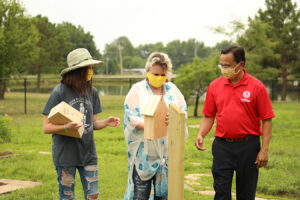TAHLEQUAH, Okla. — The Cherokee Nation has installed 16 new bee pollinator homes in the tribe’s heirloom garden in Tahlequah as part of a new initiative by First Lady January Hoskin to boost the population of pollinators while improving the environment.

One of 16 newly-installed pollinator homes placed on the Heirloom Garden grounds in Tahlequah, Okla. The pollinator homes are similar to a bird house in shape and have pre-drilled holes in the wood for bees to nest. Some of the pollinator homes, such as this one, include small slits in the wood, allowing butterflies a safe place to get away from harsh weather conditions such as rain and wind. (Cherokee Nation photos)
Principal Chief Chuck Hoskin Jr. joined First Lady Hoskin and First Daughter Jasmine Hoskin at the heirloom garden recently to hang the new pollinator homes, which will play an important role in creating sustainable habitats for pollinators such as bees. Pollinators affect one-third of food supplies across the U.S., including the traditional Cherokee plants housed in the heirloom garden.
“As First Lady of the Cherokee Nation and as the mother and grandmother of Cherokee children, caring for our environment is an issue that is important not only to me, but to the next seven generations of Cherokee Nation citizens,” said First Lady Hoskin. “Pollinators like bees and butterflies face increasing threats of extinction because of habitat loss. The pollinator houses we are hanging will play an important role in supporting and sustaining the traditional plants in the Cherokee Nation Heirloom Garden. I encourage Cherokees to make their own pollinator houses, plant pollinator-friendly plants, and support the bees and butterflies living in their own backyard.”
There are over 4,000 species of native bees in North America. With increasing use of pesticides as well as habitat loss, native bees have seen a decline in population in recent years. The 16 new pollinator homes will provide hundreds of native bees and other pollinators a safe place to live.
“Every piece of food we eat is a result of these insects,” said Cherokee Nation Senior Director of Environmental Resources Pat Gwin. “So, take a sunflower for example; they pollinate the female flower which will grow into the sunflower seed, which we eat. Even the meat that we eat – deer or cows eat the plants that are being pollinated by these insects. If we take care of bees and other pollinators, they will take care of our pollinating needs that allow for us to supply thousands of plant materials to Cherokees.”

Cherokee Nation’s First Family, Principal Chief Chuck Hoskin Jr., First Lady January Hoskin, and First Daughter Jasmine Hoskin place bee pollinator homes at the Tribe’s Heirloom Garden in Tahlequah, Okla. The pollinator homes are part of the First Lady’s initiative to help better the environment as well as to help provide a safe habitat for bees and other pollinators.
Gwin and his team maintain the Cherokee Nation Heirloom Garden and the tribe’s heirloom seed bank. The heirloom garden is home to over 200 different traditional plants and 26 crops that were used by Cherokees hundreds of years ago for food, ceremonies and medicinal purposes. These plants and crops include White Eagle Corn, river cane, Cherokee dipper gourds, elderberry and rattlesnake master, among others.
After Cherokees were forcefully removed to present-day Oklahoma, the unique heirloom crops Cherokees grew were nearly lost. The Cherokee Nation Heirloom Garden was created to grow, preserve and share these plants and crops that are precious to the Cherokee culture.
The heirloom crops and native plants grown each year in the garden also help replenish the Cherokee Nation Seed Bank, which provides seeds to tribal citizens who are interested in growing their own traditional Cherokee crops.
The pollinator homes in the heirloom garden are similar to a bird house in shape and have pre-drilled holes in the wood for bees to nest. Some of the pollinator homes also include small slits in the wood, allowing butterflies a safe place to get away from harsh weather conditions such as rain and wind.
– Cherokee Nation release




